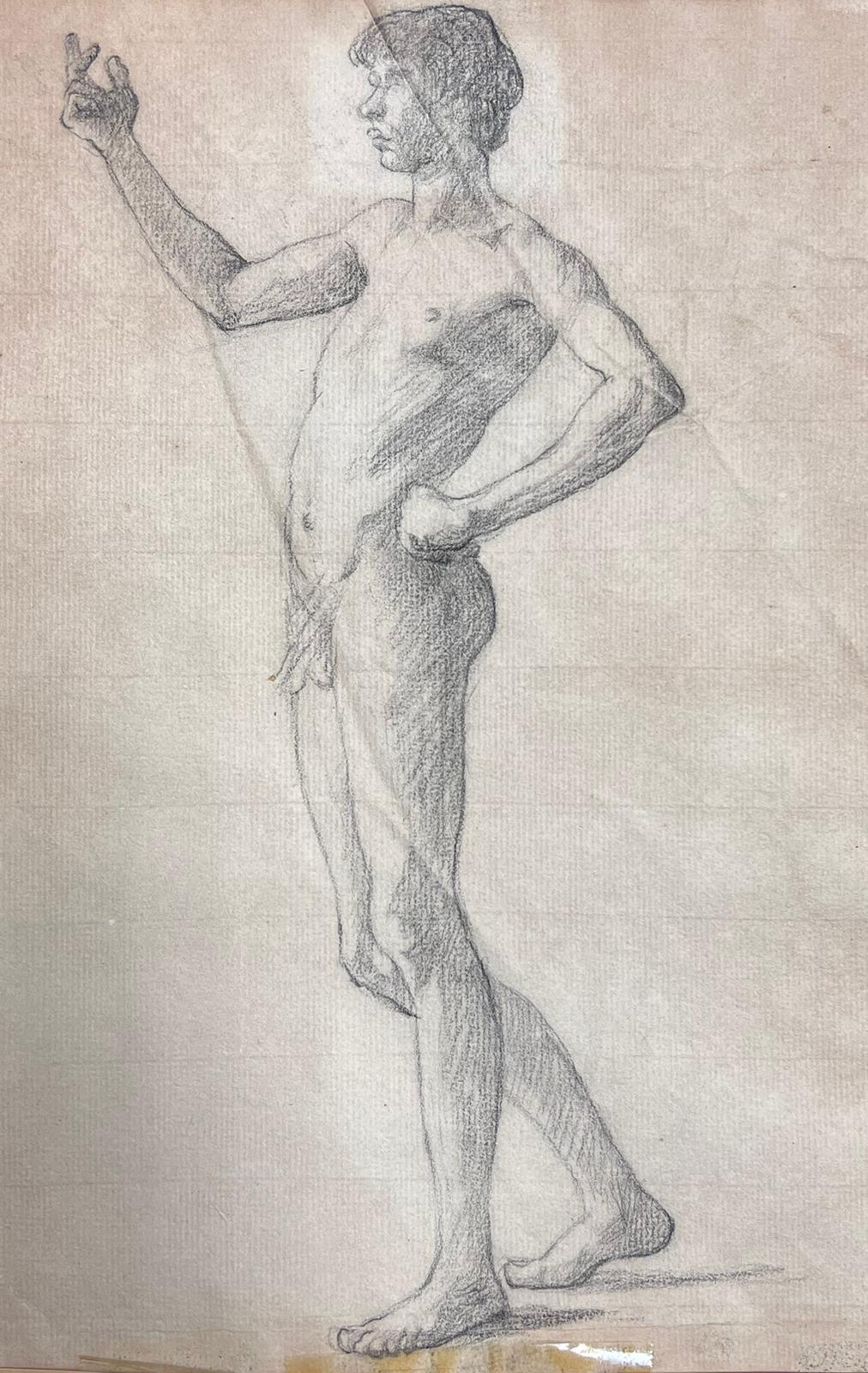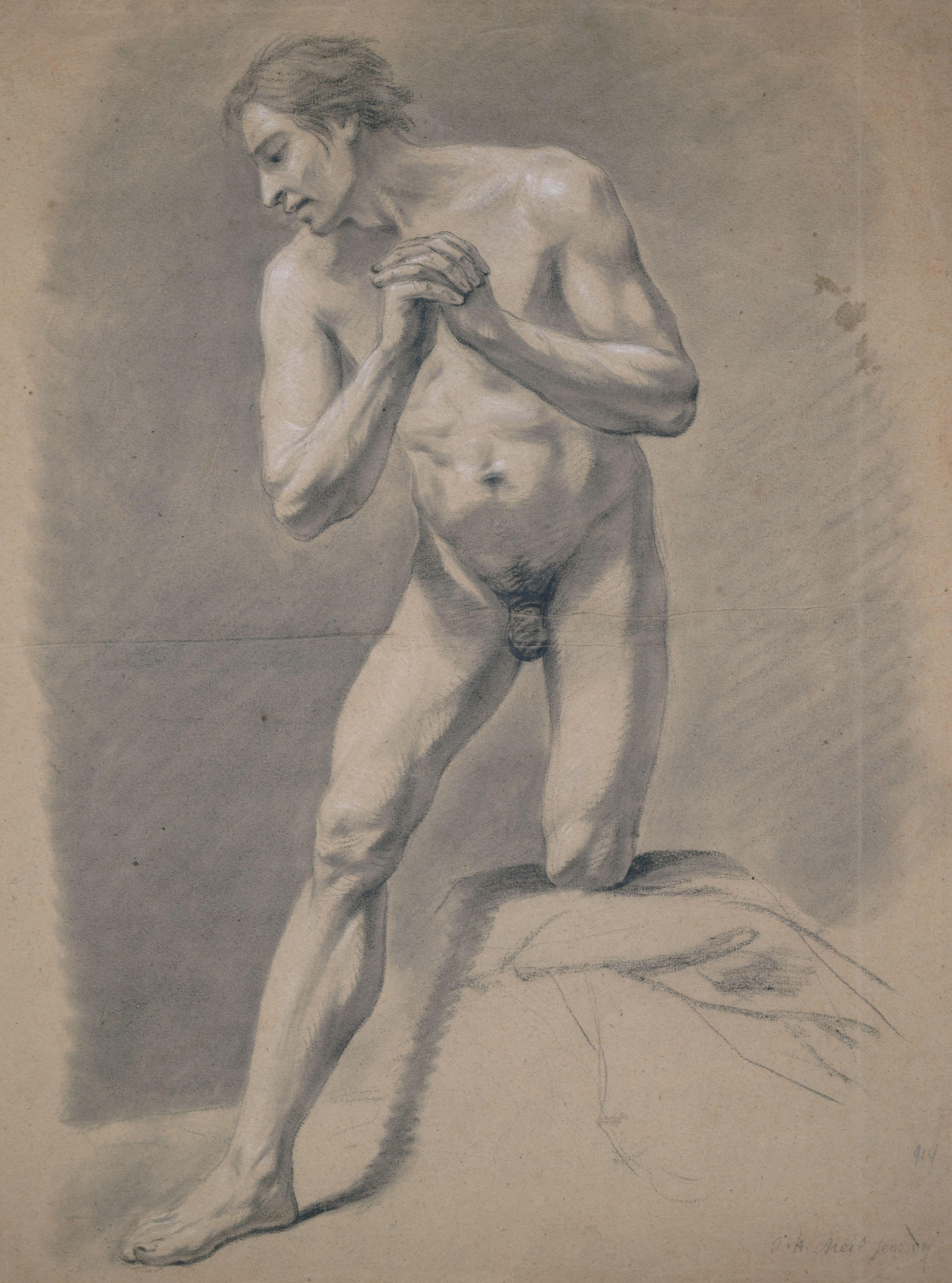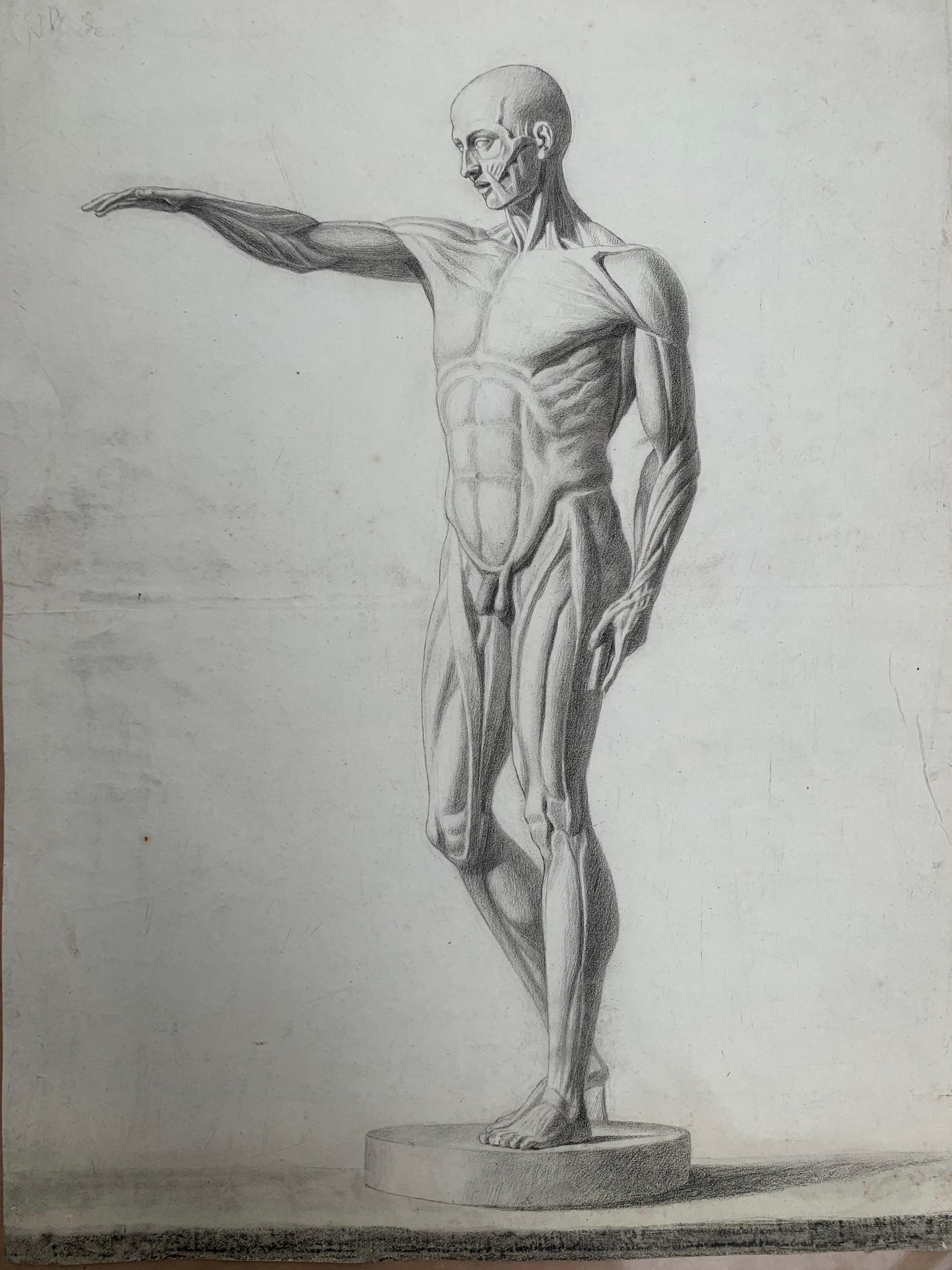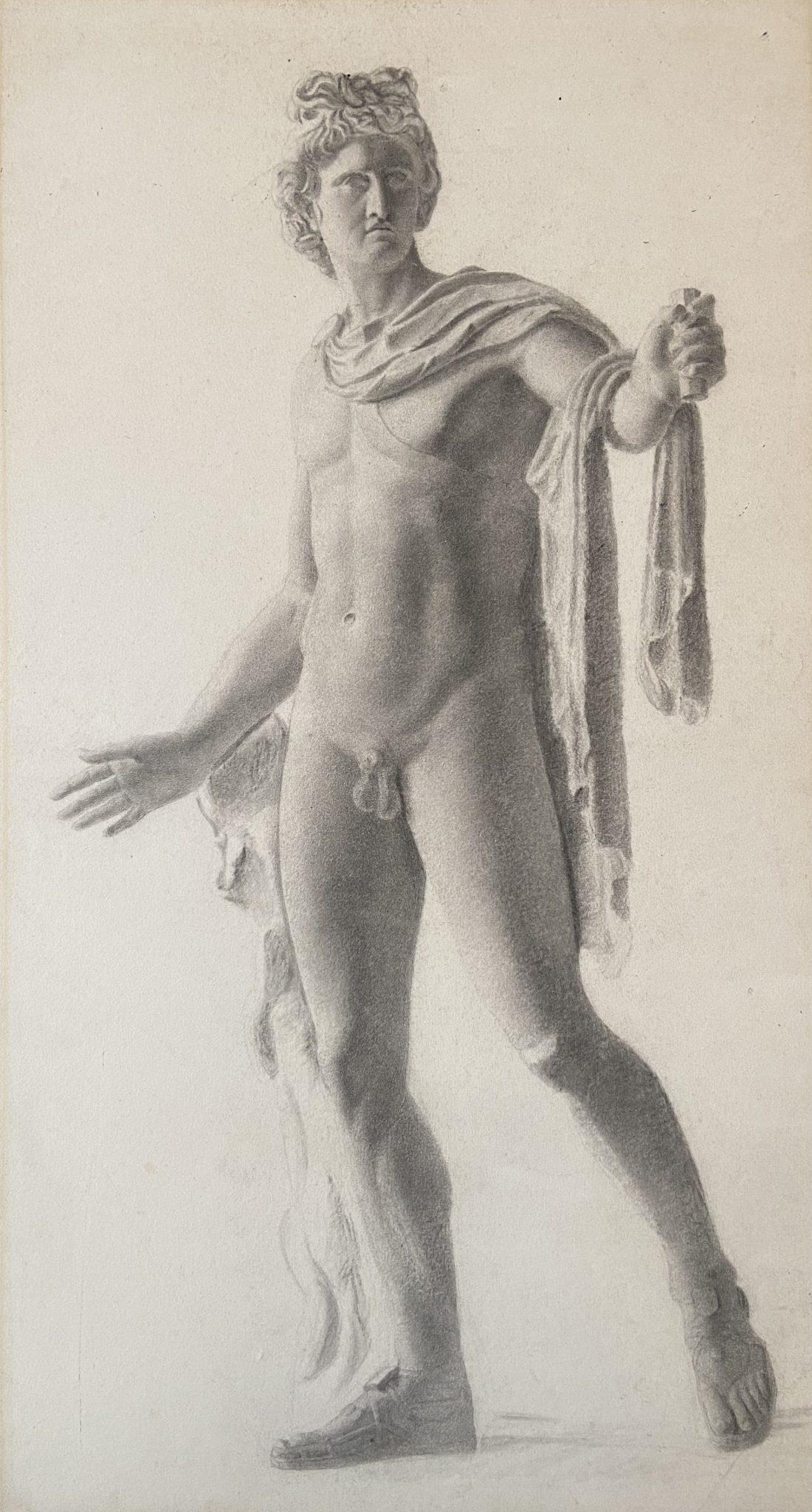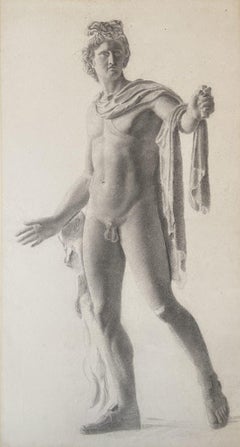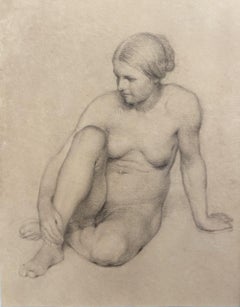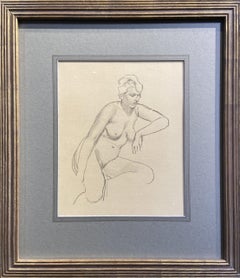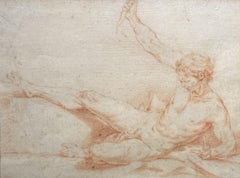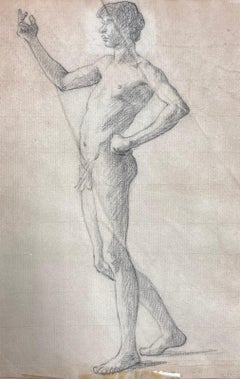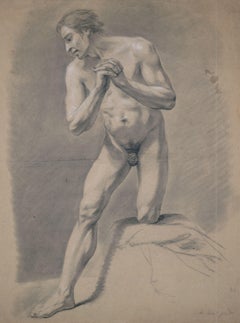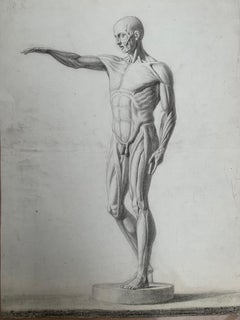Items Similar to Anatomy of Man, Signed Graphite Nude Sketch on Paper, 19th Century French Artist
Want more images or videos?
Request additional images or videos from the seller
1 of 6
Leon BellemontAnatomy of Man, Signed Graphite Nude Sketch on Paper, 19th Century French Artist
$6,531.81
£4,800
€5,639.20
CA$8,973.60
A$10,018.18
CHF 5,249.38
MX$122,632.40
NOK 66,667.15
SEK 62,858.66
DKK 42,085.95
Shipping
Retrieving quote...The 1stDibs Promise:
Authenticity Guarantee,
Money-Back Guarantee,
24-Hour Cancellation
About the Item
Graphite on laid paper, signed verso and paper watermarks and atelier stamp
Image size: 23 ¾ x 16 ¾ inches (60.25 x 43.5 cm)
Gilt Whistler frame
Leon Bellemont
Born on August 20, 1866, in the family home on rue du Grand-Cloître, Léon Bellemont studied from 1875 to 1883 at the Diderot college, where he was an excellent student. At the same time, he joined the municipal drawing school, where his exceptional predispositions were very quickly noted.
In 1884, at the age of 18, Léon Bellemont left Langres to join Paris and its National School of Decorative Arts, then the prestigious Ecole des Beaux-Arts. There, he followed the teaching of Léon Bonnat, a renowned portraitist, and obtained his first rewards and several prizes. It was in 1892, however, that his artistic career took off, with his first participation in the Salon des artistes français, where he exhibited until 1956.
A landscape and impressionist painter, particularly impressing marine worlds, Léon Bellemont stayed more and more regularly in Brittany at the beginning of the 20th century, where he painted numerous paintings. His notoriety grew, as did the profits from his sales, and the State itself ended up placing a few orders with him. His work “The Breton Faith” was, for example, acquired by the museum in Buenos Aires (Argentina).
Subsequently, always in search of inspiration, Léon Bellemont travelled extensively. He was in Bruges from 1907 to 1909, then traveled across France for several years participating in exhibitions. During the First World War, he settled in Algiers where he remained for several years. He then returned to Paris, worked extensively there and achieved great fame. A socialite, he frequented salons and regularly received his friends Jules Adler, Gabriel Fauré and his compatriot from Haut-Marne Camille Flammarion. During all his wanderings, one constant remained: he regularly returned for short stays, over the decades, in his good hometown of Langres.
In 1956, on the death of his wife Charlotte-Marie-Lucie Pizzetta (married in 1904), he returned to the department and settled in Arc-en-Barrois where he died on January 18, 1961. His niece, Simone Fèvre, was also a recognised Haut-Marne artist. Who also donated a self-portrait of his uncle to the Guy-Baillet museum. Which also preserves a second painting by Léon Bellemont: The Catechism.
- Creator:Leon Bellemont (French)
- Dimensions:Height: 23.75 in (60.33 cm)Width: 16.75 in (42.55 cm)
- More Editions & Sizes:1 of 1Price: $9,907
- Medium:
- Movement & Style:
- Period:
- Condition:
- Gallery Location:London, GB
- Reference Number:1stDibs: LU52413325342
About the Seller
5.0
Vetted Professional Seller
Every seller passes strict standards for authenticity and reliability
Established in 2007
1stDibs seller since 2014
82 sales on 1stDibs
Typical response time: 2 hours
- ShippingRetrieving quote...Shipping from: London, United Kingdom
- Return Policy
Authenticity Guarantee
In the unlikely event there’s an issue with an item’s authenticity, contact us within 1 year for a full refund. DetailsMoney-Back Guarantee
If your item is not as described, is damaged in transit, or does not arrive, contact us within 7 days for a full refund. Details24-Hour Cancellation
You have a 24-hour grace period in which to reconsider your purchase, with no questions asked.Vetted Professional Sellers
Our world-class sellers must adhere to strict standards for service and quality, maintaining the integrity of our listings.Price-Match Guarantee
If you find that a seller listed the same item for a lower price elsewhere, we’ll match it.Trusted Global Delivery
Our best-in-class carrier network provides specialized shipping options worldwide, including custom delivery.More From This Seller
View AllStudy of the Apollo Belvedere, Graphite Sketch, 19th Century
Located in London, GB
Graphite on paper
Image size: 13 3/4 x 26 inches (35 x 66 cm)
This is most likely to be a drawing from an Academy student, executed as part of their academic training. The academic ...
Category
19th Century Nude Drawings and Watercolors
Materials
Graphite
Study of a Woman Sitting, Graphite Drawing, 19th Century French School
Located in London, GB
Graphite on paper
Image size: 13 x 10 1/2 inches (33 x 27 cm)
Mounted
This is a delicate 19th century academic graphite drawing of a seated female nude in the neoclassical style.
A...
Category
19th Century French School Nude Drawings and Watercolors
Materials
Paper, Graphite
Nude Study, Graphite on Paper, 20th Century British Artwork
By William Dring
Located in London, GB
Graphite on paper
Image size: 22 x 26 inches (56 x 66 cm)
Mounted and framed
William Dring
Dring was born with the forenames Dennis William, but was known colloquially as John. He was the brother of the artist James Dring. He married the painter Grace Elizabeth Rothwell...
Category
20th Century Nude Drawings and Watercolors
Materials
Paper, Graphite
The Death of Attis, 18th Century French Red Chalk Drawing, Greek Mythology
Located in London, GB
Red chalk on paper
Image size: 9 x 7 inches (23 x 17.75 cm)
Acid free mount
The Greek god Attis was the spouse of Cybele, the fertility goddess. He was from Phrygia, a kingdom in c...
Category
18th Century French School Figurative Drawings and Watercolors
Materials
Chalk
Essence of Line, Ink Nude Study, Early 20th Century Drawing, Signed and Dated
Located in London, GB
Ink on paper, signed and dated '34 lower left
Image size: 9 3/4 x 15 inches (24.75 x 24.5 cm)
Mounted and framed
A unique drawing, this work is typical of Brodzky's early nudes with its economy in the use of the line and the seemingly relaxed, informal pose of the model. The spontaneous feel of many of Brodsky's drawings does in a way indicate that the works, such as the present drawing, are purely sketches and studies. In fact, Brodsky was known for making perhaps twenty or thirty drawings at a sitting and of those he preserved perhaps only a handful, only those that 'pass his rigorous censorship sum up qualities resulting from the perfect collaboration of hand and eye and sensibility' (Forty Drawings by Horace Brodsky, by James Laver, 1935, p.15).
Laver continued to write that 'Brodsky preferred a pose that showed the body from an unexpected angle, daringly foreshortened or with the weight of the various parts freed from the monotony of the standing pose. He liked to see his models from above, the limbs relaxed, and.... he made many of his drawings from a step-ladder drawn up close to the platform on which the model is lying'.
Horace Brodsky
Horace Ascher Brodzky (30 January 1885 – 11 February 1969) was an Australian-born artist and writer most of whose work was created in London and New York. His work included paintings, drawings and linocuts, of which he was an early pioneer. An associate in his early career of many leading artists working in Britain of his period, including Henri Gaudier-Brzeska, Mark Gertler, and members of the Vorticism movement, he ended his life relatively neglected.
Brodzky was born in Kew, Melbourne in 1885 to the Australian journalist Maurice Brodzky (a Jewish immigrant to Australia from Poland), and his wife Flora, née Leon. In his youth he assisted his father in the production of the magazine Table Talk.
Brodzky studied initially at the National Gallery School in Melbourne. In 1904 his father was bankrupted after exposing corruption, and Horace moved with his family to San Francisco.
In 1908, Brodzky went to London where he studied during 1911 at the City and Guilds South London Technical Art School. He became an acquaintance and follower of Walter Sickert. Amongst his friends was Henri Gaudier-Brzeska who created in 1913 a portrait bust of Brodzky (now in the Tate Gallery, London), and whose biography he wrote in 1933. Brodzky is said to have been so engrossed in talk when he visited Gaudier-Brzeska's studio in the King's Road, that he missed the last bus to Herne Hill where he lived.
Brodzky travelled to Italy with the poet John Gould Fletcher and this led to his first London exhibition, "Paintings and Sketches of Italian and Sicilian Scenes" (c. 1911), of which one painting was selected for the 1912 Venice Biennale. He was in fact the first Australian to be exhibited at the Biennale. In 1914 his work was exhibited along with that of other Jewish artists, including Mark Gertler and David Bomberg, in the Whitechapel Gallery. Brodzky became a member of The London Group. During this period he was a pioneer of the technique of linocut, in which medium he has been said to have "excelled". His early oils reveal the influence of both Gertler and Bomberg. Among his works of this period are portraits of Jacob Epstein and Jacob Kramer.
In 1915 Brodzky moved to New York, with an introduction to the art patron John Quinn. There he worked as a poster artist and an arts journalist, and in 1917 helped Quinn organize a New York exhibition of Vorticist artists. In 1919 he married Bertha Greenfield; they were to have three sons. In 1920 Egmont Arens...
Category
1930s Modern Nude Drawings and Watercolors
Materials
Paper, Ink
Sketch of Antinous
Located in London, GB
Alfred Hunt
1830-1896
Graphite and wash on paper, inscribed lower right
Image Size: 9 ¾ x 10 ¾ inches (24.6 x 26.5 cm)
Mounted
This Sketch by Hunt is a rough study of the relief of ...
Category
19th Century Figurative Drawings and Watercolors
Materials
Pencil
You May Also Like
19th Century French Academic Drawing Portrait of Male Nude Young Man
Located in Cirencester, Gloucestershire
The Artists Model
Portrait of a Young Male Nude
French, late 19th century
pencil drawing on artist paper, unframed
with further sketches verso
artist paper: 13 x 9.5 inches
provenanc...
Category
Late 19th Century French School Nude Paintings
Materials
Pencil
Male Nude / - The Drama of the Nude -
Located in Berlin, DE
Johann Heinrich Meil (1730 Gotha - 1820 Berlin), Male Nude, 1807. White heightened, occasionally wiped charcoal drawing on brownish paper, 51 cm x 39.5 cm, signed “J.[ohann] H.[einri...
Category
Early 19th Century Rococo Nude Drawings and Watercolors
Materials
Paper
Pre-Second Republic Academic Study Of A Male Nude Framed 1840s French Drawing
Located in Sutton Poyntz, Dorset
Henry Arthur Roberts.
French ( b.1819 - d.1900 ).
Academic Life Study Of A Standing Male Nude.
Pencil & Charcoal On Paper.
Paper size 23.8 inches x 13.6 inches ( 60.5cm x 34.5cm ).
Frame size 28.3 inches x 18.7 inches ( 72cm x 47.5cm ).
Available for sale; this academic life drawing of a male nude is by the French artist Henry Arthur Roberts and dates from the early 1840s.
The drawing is presented and supplied in a modest hand painted glazed wooden frame dating from the mid-20th century (which is shown in these photographs).
This antique drawing is in good condition, commensurate with its age. It is in an untouched condition having never been restored. The paper has handling marks, some light surface dirt, the odd foxing mark and general age toning. The overall patina adds to the aesthetic and is supplied ready to hang and display.
The drawing is not signed but came from a portfolio of drawings by Henry Arthur Roberts.
Henry Arthur Roberts was a recognised French artist, notable for his portraits and paintings of religious subjects. Born in Paris in 1819, he was the son of British watercolour artist James Roberts, himself active in Paris from 1819 -1846. Henry became a student of his father.
Henry Roberts’s talent as a young man was such that he was accepted as a student of Michel Martin Drölling and worked extensively with him. Drölling, the highly acclaimed neoclassic artist (1786-1851) was noted for his theatrical paintings of history and grand portraits. He produced many notable works, including a ceiling work for the Louvre, and works in the Palace of Versailles. Roberts would have studied with Drölling at an early stage in his career, as Drölling died when Roberts was 32. Learning with such a master would have had a huge impact on Roberts in terms of his academic skills and his own emerging style.
Roberts exhibited at the Salon de Paris from 1839, when he was only 20 years old, right through to 1867. His work in the Universal Exhibition of 1855 won him a Third Class Medal. He became Vice-President of the Association of Artists in Paris and in July 1898 he was elevated to the rank of Knight of the Legion of Honour with a foreign title. This was the highest state honour available to him, in recognition of his status as an artist.
Henry Roberts died in 1900, but his legacy lives on, with works in many famous public collections, including the Musée Carnavalet, the Musée du Louvre, the Musée d’Orsay, Musée des Beaux-Arts, Orsay, and in Boston, USA.
© Big Sky Fine Art
This exceptional academic nude...
Category
1840s Academic Nude Drawings and Watercolors
Materials
Charcoal, Paper, Pencil
Academic drawing: L'Écorché by Houdon. Italian school. 19th century. 59x44cm
Located in Firenze, IT
Academic drawing: L'Écorché by Houdon. Italian school. 19th century. 59x44cm
This represents the statue of the écorché by the French sculptor Houdon.
Sculpture - Anatomical model o...
Category
Mid-19th Century Academic Nude Drawings and Watercolors
Materials
Paper, Charcoal
Drölling Student Academic Life Study Of A Male Nude Framed 1840s French Drawing
Located in Sutton Poyntz, Dorset
Henry Arthur Roberts.
French ( b.1819 - d.1900 ).
Academic Life Study Of A Male Nude Carrying A Staff.
Pencil & Charcoal On Paper.
Paper size 23.4 inches x 13.6 inches ( 59.5cm x 34.5cm ).
Frame size 28.3 inches x 18.7 inches ( 72cm x 47.5cm ).
Available for sale; this academic life drawing of a male nude is by the French artist Henry Arthur Roberts and dates from the early 1840s.
The drawing is presented and supplied in a modest hand painted glazed wooden frame dating from the mid-20th century (which is shown in these photographs).
This antique drawing is in good condition, commensurate with its age. It is in an untouched condition having never been restored. The paper has handling marks, some light surface dirt, the odd foxing mark and general age toning. The overall patina adds to the aesthetic and is supplied ready to hang and display.
The drawing is not signed but came from a portfolio of drawings by Henry Arthur Roberts.
Henry Arthur Roberts was a recognised French artist, notable for his portraits and paintings of religious subjects. Born in Paris in 1819, he was the son of British watercolour artist James Roberts, himself active in Paris from 1819 -1846. Henry became a student of his father.
Henry Roberts’s talent as a young man was such that he was accepted as a student of Michel Martin Drölling and worked extensively with him. Drölling, the highly acclaimed neoclassic artist (1786-1851) was noted for his theatrical paintings of history and grand portraits. He produced many notable works, including a ceiling work for the Louvre, and works in the Palace of Versailles. Roberts would have studied with Drölling at an early stage in his career, as Drölling died when Roberts was 32. Learning with such a master would have had a huge impact on Roberts in terms of his academic skills and his own emerging style.
Roberts exhibited at the Salon de Paris from 1839, when he was only 20 years old, right through to 1867. His work in the Universal Exhibition of 1855 won him a Third Class Medal. He became Vice-President of the Association of Artists in Paris and in July 1898 he was elevated to the rank of Knight of the Legion of Honour with a foreign title. This was the highest state honour available to him, in recognition of his status as an artist.
Henry Roberts died in 1900, but his legacy lives on, with works in many famous public collections, including the Musée Carnavalet, the Musée du Louvre, the Musée d’Orsay, Musée des Beaux-Arts, Orsay, and in Boston, USA.
© Big Sky Fine Art
This striking academic nude study...
Category
1840s Academic Nude Drawings and Watercolors
Materials
Paper, Charcoal, Pencil
Anatomy Studies - Etching by Nicholas Cochin - 1755
Located in Roma, IT
Anatomy Studies is an etching realized by Nicholas Cochin in 1755.
Signed in the plate.
Good conditions with foxing and folding.
The artwork is depicted through confident strokes....
Category
1750s Surrealist Figurative Prints
Materials
Etching
More Ways To Browse
19th Century Sketches
19th And 20th Century French Paintings
Nude Paintings 1961
Socialite Painting
Faure Artist
Socialite Portrait Painting
16x20 Gilt Frame
Leon Bonnat
Camille Faure
Jules Breton
Academic Male Nude
Academic Male Nude Paintings
Academic Drawing Male Nude
Seated Male Nude Drawing
Academic Figural Male Nude Drawing
Male Nude Pastel
Nick Knight
19th Century Male Nude Paintings
